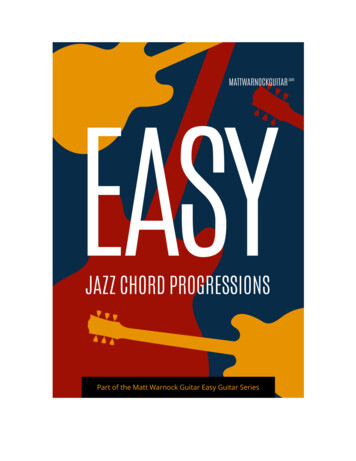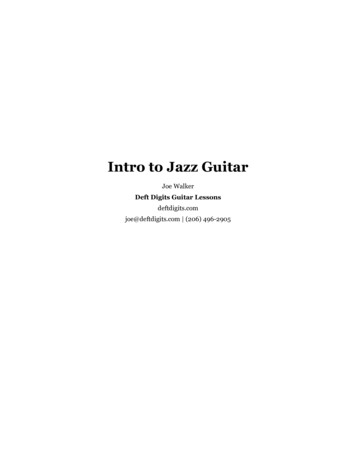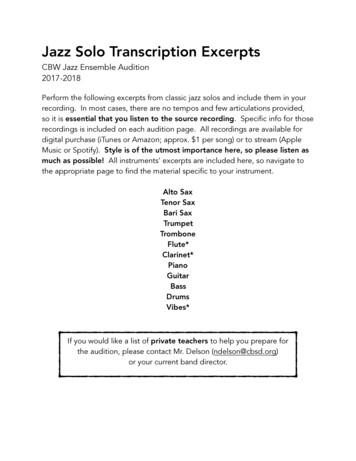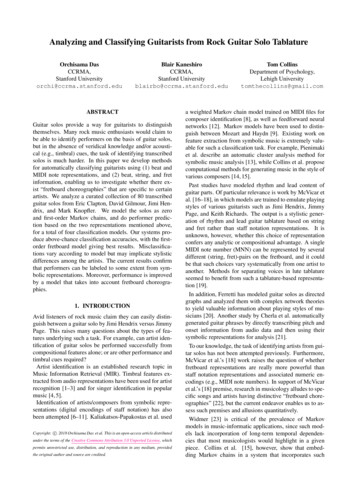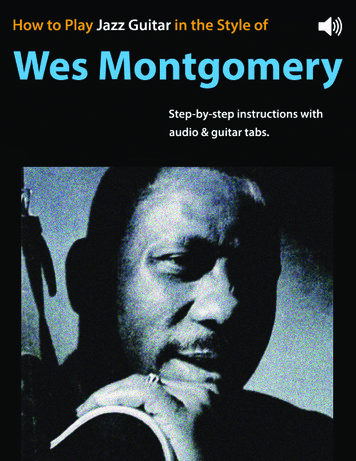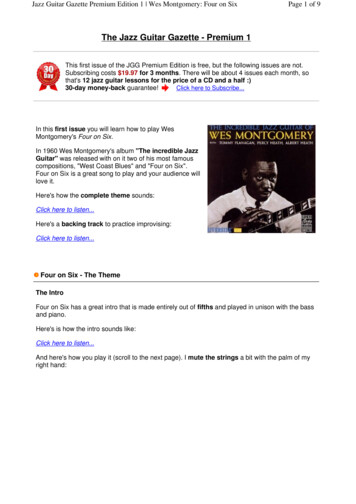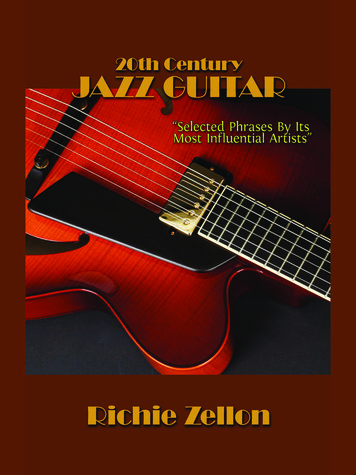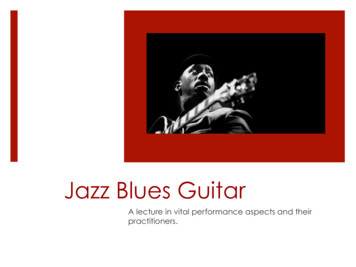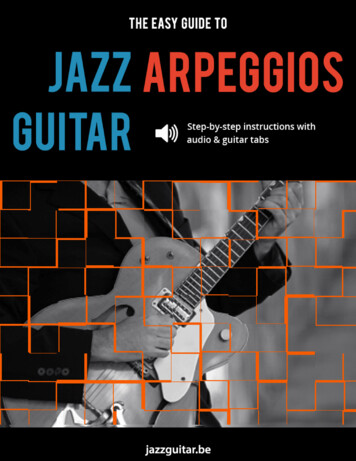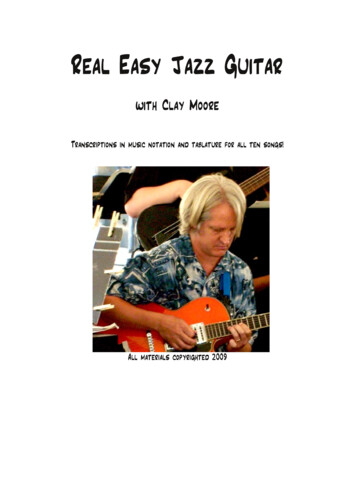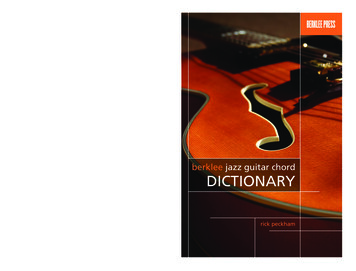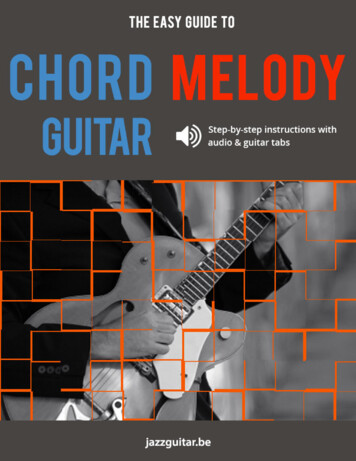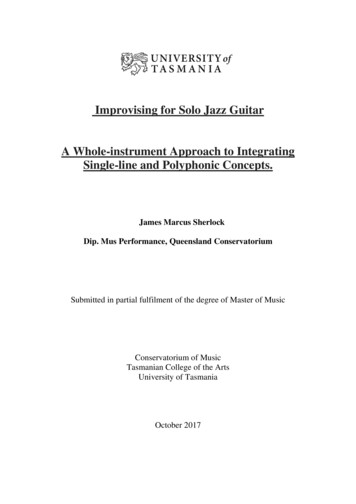
Transcription
Improvising for Solo Jazz GuitarA Whole-instrument Approach to IntegratingSingle-line and Polyphonic Concepts.James Marcus SherlockDip. Mus Performance, Queensland ConservatoriumSubmitted in partial fulfilment of the degree of Master of MusicConservatorium of MusicTasmanian College of the ArtsUniversity of TasmaniaOctober 2017
DeclarationThis exegesis contains the results of research carried out at the University of Tasmania,Conservatorium of Music between 2013 and 2017. It contains no material that, to myknowledge, has been accepted for a degree or diploma by the University or any otherinstitution, except by way of background information that is duly acknowledged in theexegesis. I declare that this exegesis is my own work and contains no nexceptwhereclearacknowledgement or reference has been made in the text. This exegesis may be madeavailable for loan and limited copying in accordance with the Copyright Act 1968.
iiTable of ContentsAcknowledgements .iiiList of Figures . ivList of Audio Excerpts . viAbstract . viiiPreface . ixChapter 1: Literature Review . 1Broad Focus Works. 1Guitar-Specific Method Books . 4Non-Guitar Specific Sources . 9Recordings: Guitar in Ensemble Format . 11Recordings: Solo Guitar . 14Recordings: Other Instruments . 17Chapter 2: Methodology . 21Chapter 3: Key Improvising Concepts in Solo Performance . 24Melodic Chords/Harmonic Melodies. 25Integration of Melodic and Chordal Playing . 32Rhythmic Drive and Clarity, Forward Motion and Time Feel . 37Deep Understanding of the Material . 44Chapter 4: Creating Variety in Improvised Solo Guitar Performance . 46Rhythmic Variety . 47Variety of Repertoire . 55Variety of articulation and tonal variation . 58Chapter 5: Recital Three-New Developments and Refinement of CoreConcepts. 64Chapter 6: Conclusion. 72Bibliography . 78Discography . 80Appendix 1: Video Recordings of Recital PerformancesRecital One 24th February 2015Recital Two 27th August 2015Recital Three 22nd November 2016Appendix 2: Audio Excerpts
iiiAcknowledgementsI would like to take this opportunity to thank my supervisors, Dr Glen Hodges and DrNick Haywood for taking on this project and for their invaluable help throughout. Iwould also like to acknowledge the vital input of Dr Anne-Marie Forbes. Also thanksto Caleb Miller, Robert Rule and the other staff members from UTAS for their helpin the preparation and recording of the recitals.
ivList of FiguresFigure 1Peter Bernstein: Chord VoicingsFigure 2Wynton Kelly: Freddie Freeloader (Excerpt)Figure 3Wynton Kelly: Guitar ReductionFigure 4Sonny Rollins/Charlie Parker/Sonny Stitt (Excerpt)Figure 5Dewey Square (Recital One Excerpt)Figure 6Wes Montgomery: Gone with the Wind (Excerpt)Figure 7Fried Bananas (Recital One Excerpt)Figure 8Never Let Me Go (Recital One Excerpt)Figure 9Kenny Burrell: Chitlins Con Carne (Excerpt)Figure 10Kurt Rosenwinkel: Lazy Bird (Excerpt)Figure 11Fried Bananas (Recital One Excerpt)Figure 12Peri’s Scope (Recital One Excerpt)Figure 13Domestic Arts (Recital One Excerpt)Figure 14Moose the Mooche (Lead Sheet)Figure 15Brown/Coltrane/Parker/Rollins (Excerpt)Figure 16Fried Bananas (Recital One Excerpt)Figure 17Domestic Arts (Recital One Excerpt)Figure 18Domestic Arts (Recital One Excerpt)Figure 19Watermark (Recital One Excerpt)Figure 20Autumn in New York (Recital Two Excerpt)Figure 21What is this Thing Called Love? (Recital Two Excerpt)
vFigure 22Lullaby of the Leaves (Recital Two Excerpt)Figure 23Comparison TableFigure 24Micro-Rhythm ExamplesFigure 25Get Out of Town (Recital Three Excerpt)Figure 26Bluesette (Recital Three Excerpt)Figure 27Con Alma (Recital Three Excerpt)Figure 28Here’s That Rainy Day (Recital Three Excerpt)Figure 29Con Alma (Recital Three Excerpt)
viList of Audio ExcerptsEx 1Dewey Square (a)Ex 2Fried Bananas (a)Ex 3Never Let Me GoEx 4Fried Bananas (b)Ex 5Peri’s ScopeEx 6Domestic Arts (a)Ex 7Fried Bananas (c)Ex 8Domestic Arts (a)Ex 9Domestic Arts (b)Ex 10WatermarkEx 11Autumn in New YorkEx 12What is This Thing Called Love?Ex 13Lullaby of the LeavesEx 14Wrapped Around Your Finger (a)Ex 15Wrapped Around Your Finger (b)Ex 16ConceptionEx 17Dewey Square (b)Ex 18Wrapped Around Your Finger (c)Ex 19Wrapped Around Your Finger (d)Ex 20What is This Thing Called Love? (b)Ex 21Wrapped Around Your Finger (e)
viiEx 22Autumn in New York (b)Ex 23Get Out of Town (a)Ex 24BluesetteEx 25Get Out of Town (b)Ex 26Get Out of Town (c)Ex 27Get Out of Town (d)Ex 28Get Out of Town (e)Ex 29Get Out of Town (f)Ex 30Get Out of Town (g)Ex 31Con Alma (a)Ex 32Here’s That Rainy DayEx 33Con Alma (b)
viiiAbstractHistorically within the jazz idiom, the guitar has predominantly functioned withinensembles of various sizes. A focus of this study is an investigation into theguitarist’s potential to improvise completely unaccompanied, without the rhythmicsecurity of drums or the harmonic and structural security of bass or piano. Thisrequires not only a solid grounding in harmony, rhythm, and melody but also shouldincorporate integration of the melodic and accompaniment roles. This integration ofroles is the key focus of this study. In jazz, the piano is the instrument most wellknown for solo performance due to the obvious advantages of being able to play leftand right hands independently. The guitar by comparison initially appears to havelimited possibilities when played solo. This work seeks to find solutions for thisproblem as developed in my own practice through performance and reflective andinvestigative analysis; solutions that take advantage of the guitar’s uniquecharacteristics.The outcomes of this research will be documented in a folio of three recorded soloperformance recitals and an accompanying exegesis outlining the key findings basedon analysis of these performances. The findings will outline solutions to the problemsassociated with solo guitar performance and address the integration of chordal andmelodic playing as well as vital rhythmic, melodic, harmonic and textural concepts.
ixPrefaceImprovising solo guitar is difficult, the guitar “falls between the cracks” of being achordal instrument and a melodic instrument. The guitarist does not have thepotential harmonic palette available to a pianist or the voice-like quality and melodicweight of the saxophone or trumpet. The guitar does have however, its own inherentexpressive melodic qualities and a unique chordal language that makes it ideal forsolo improvised performance, despite the apparent restrictions. The challenge insolving these problems in a musical way, that allows the performer freedom ofexpression, whilst providing the listener with a complete and varied experience is thefocus of this study.My unique style of jazz guitar playing, based on a conceptual approach developedover many years, has led me to investigate a question that has become ubiquitous inthe field. “Why do jazz improvisers on guitar separate and compartmentalize theirchordal and melodic thinking?” My experience has been that the more I can integratethese aspects of my playing the more successful I can be as both a solo improviserand as an ensemble member, especially in situations where the guitar is providing theharmonic and chordal texture.
xGuitarists have historically tended to favour or pragmatically fulfil one of two roles.The approaches can loosely be termed “chordal” or “melodic”. In popular androck/blues music styles these roles are often referred to as “rhythm” and “lead”, oftendue to different playing circumstances or particular stylistic traits of the music. Manyguitarists tend to temporarily or even permanently focus on one role, for examplerhythm guitarist with the Count Basie orchestra, Freddie Green. Green providedharmonic and rhythmic support for the Basie band which became the standard guitarrole in the pre-electric guitar big band. Specialising in this style of rhythm guitarwould naturally lead players to become focused on the chordal aspect of the guitar.Guitarist Grant Green was a prolific presence on the recordings of Blue Note recordsthroughout the 1960s. Green’s playing was influenced by saxophone players andunlike Freddie Green, he rarely played any chords, instead choosing to concentrate onhorn-like single line improvising. Even on his 1961 trio release Green Street whereGreen is the only chordal instrument, he rarely plays anything more than a two-notechord, instead relying on the phrasing, tone and time feel of his linear improvising tocreate interest.There is another approach to the instrument that is generally regarded aspredominantly the realm of classical guitarists (with the requisite pre-composedrepertoire). This solo approach is aided by repertoire that is arranged or written withthe idiosyncrasies of the guitar in mind. Improvising players who wish to play solo orat least potentially combine the dual roles, often approach the problem by becomingadept at arranging. In some cases, players develop a conceptual framework for
xiapproaching the task of realising the functionary demands of this combined stylewhile being free to include either small or larger improvisatory excursions. It is inthis latter category that my own professional practice has developed.This study does not seek to critique or pronounce value judgements on the work ofpredominantly melodic or chordal focused players, rather it is an exploration andinvestigation of my own processes as I endeavour to develop a unique and functionalstyle that combines chordal and melodic playing in an improvisatory context.
Chapter 1: Literature ReviewThere is a large range of literature broadly relating to musical improvisation,however, the focused nature of this project is more beneficially informed by a definedset of sources which can be grouped into three categories:1. Musical and instructional works from artists that have in a broad sensecontributed to or informed my own style of conceptual framework and range oftechniques2. Guitar methodologies or instructional works from these artists3. Recorded works of other artists who have taken a different approach to thisperformance problem.Broad Focus WorksThere has been much written about improvisation in a broad sense. Works such asBerliner’s “Thinking in Jazz” (1994), Stephen Nachmanovitch’s “Free Play:Improvisation in Life and Art” (2002) and “Improvisation: Its Nature and Practice inMusic” (1993) by Derek Bailey deal with larger conceptual issues. This study is notconcerned with articulating or challenging accepted notions of the nature ofimprovisation and as such these works are useful in a contextual sense only.More apposite are a range of primary source materials drawn from artist interviewsand biographical accounts.
2“The Guitar in Jazz” (1996) by J. Sallis contains various biographical and historicalaccounts of players with some insightful comments from players in variousinterviews. This text is of use as it is guitar specific, although most of the playersinvolved can be categorised as either chord players or single line players, with theexception of Ralph Towner who discusses interesting ideas, although distanceshimself from the term “jazz” and approaches the guitar more from a compositionalrather than improvisational angle.In addition to my classically styled technique, the music that I’m playing isvery keyboard-oriented. I treat the guitar like a piano trio; if I’m playingalone, it’s almost a one-man band approach. There’ll be the melodist, theinner voices, and the bass voice. I seldom run these voices through reallysimultaneously, although that’s the illusion. Each part of the music gets myattention as it’s going by. For example, if I play something melodically, I’ll tryto hang it over. If I start an inside voice beneath the melody, I’ll hold themelody; I won’t stop it and then start the inside voice. The melody gets hungover, and then I go onto the next part. The attention of the listener or theplayer flows more easily. (Towner, in Sallis 1996: 185)There are a number of relevant biographical accounts of important musician
Improvising for Solo Jazz Guitar A Whole-instrument Approach to Integrating Single-line and Polyphonic Concepts. James Marcus Sherlock Dip. Mus Performance, Queensland Conservatorium Submitted in partial fulfilment of the degree of Master of Music Conservatorium of Music Tasmanian College of the Arts University of Tasmania October 2017 . Declaration This exegesis contains the
